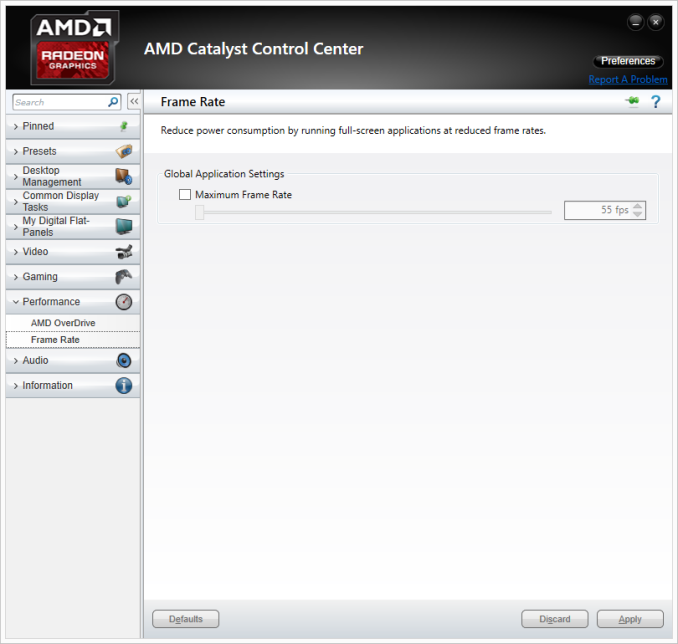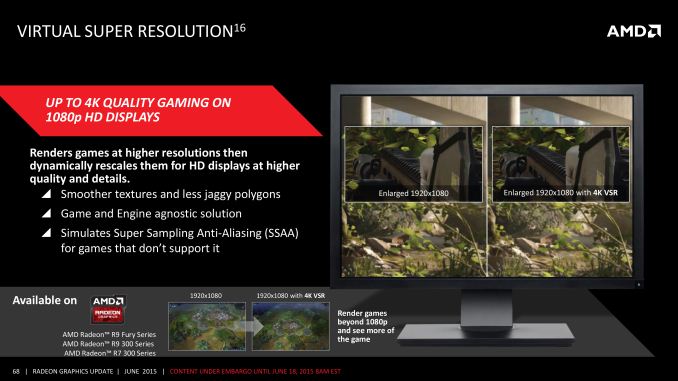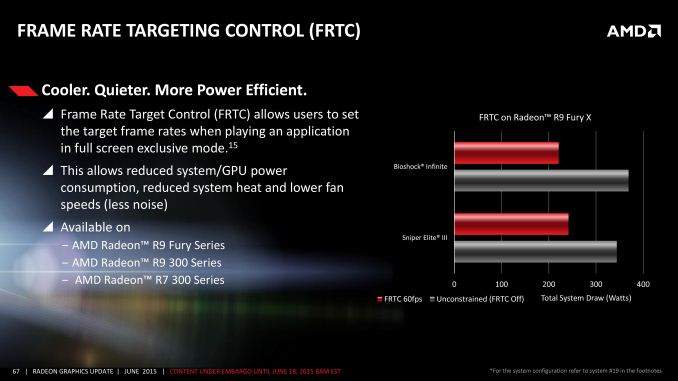The AMD Radeon R9 Fury X Review: Aiming For the Top
by Ryan Smith on July 2, 2015 11:15 AM ESTDisplay Matters: Virtual Super Resolution, Frame Rate Targeting, and HEVC Decoding
Wrapping up our look at the technical underpinnings of the Fiji GPU, we’ll end things with a look at the display and I/O stack for AMD’s latest GPU.
As a GCN 1.2 part, Fiji inherits most of its capabilities in-place from Tonga. There is one notable exception to this, HEVC, which we’ll get to in a bit, otherwise from a features standpoint you’re looking at the same display feature set as was on Tonga.
For Display I/O this means 6 display controllers capable of driving DVI, HDMI 1.4a, and DisplayPort 1.2a. Unfortunately because Tonga lacked support for HDMI 2.0, the same is true for Fiji, and as a result you can only drive 4k@60Hz displays either via DisplayPort, or via tandem HDMI connections. The good news here is that it will be possible to do active conversion from DisplayPort to HDMI 2.0 later this year, so Fiji is not permanently cut-off from HDMI 2.0, however those adapters aren’t here quite yet and there are still some unresolved questions to be addressed (e.g. HDCP 2.2).
On the multimedia front, Fiji brings with it an enhanced set of features from Tonga. While the video encode side (VCE) has not changed – AMD still supports a wide range of H.264 encode settings – the video decode side has seen a significant upgrade. Fiji is the first AMD discrete GPU to support full hardware HEVC decoding, coinciding with the launch of that feature on the GCN 1.2-based Carrizo APU as well.
A look at DXVA Checker confirms the presence of Main Profile (HEVC_VLD_Main) support, the official designation for 8-bit color support. Main profile is expected to be the most common profile level for HEVC content, so Fiji’s support of just Main profile should cover many use cases.
Unfortunately what you won’t find here is Main10 profile support, which is the profile for 10-bit color, and AMD has confirmed that 10-bit color support is not available on Fiji. As our in-house video guru Ganesh T S pointed out when looking at these results, Main10 is already being used in places you wouldn’t normally expect to see it, such as Netflix streaming. So there is some question over how useful Fiji’s HEVC decoder will be with commercial content, ignoring for now the fact that lack of Main10 support essentially rules out good support for some advanced color space features such as Rec. 2020, which needs higher bit depths to support the larger color space without extensive banding.
Meanwhile the state of AMD’s drivers with respect to video playback is hit and miss. DXVA Checker crashed when attempting to enumerate 4K resolution support on Fiji, and 4K has been something of a thorn in AMD’s side. This is also likely why Media Player Classic Home Cinema and its built-in LAV Filters are currently ignoring 4K support on Fiji and are falling back to software decoding. As a result 1080p hardware decoding works great on Fiji – both H.264 and HEVC – but getting Fiji to decode 4K content is a lot harder. Using Windows’ built-in H.264 decoder works for 4K H.264 decoding, and in the meantime it’s a bit harder to test Fiji’s HEVC capabilities at 4K since Windows 8 lacks an HEVC decoder.

Decoding 1080p HEVC In MPC-HC on Fiji
With full hardware decode support for HEVC still being relatively new in the PC space, I expect we’ll see some teething issues for some time yet. For the moment AMD needs to resolve any crashing issues and get off of LAV’s blacklist, since the LAV filters are by our estimation the most commonly used for generic HEVC media playback.
On a side note, given the fact that the Tonga GPU (R9 285) is the only GCN 1.2 GPU without HEVC decoding, I also took the liberty of quickly loading up a modified copy of the Catalyst 15.15 launch drivers for the R9 300/Fury series, and seeing if HEVC support may have been hidden in there the entire time. Even with these latest drivers, R9 285 does not support HEVC, and while I admittedly wasn’t expecting it to, I suspect there’s more to Tonga’s UVD block given its nature as the odd man out.
Last but not least, TrueAudio support is also included with Fiji. First introduced on AMD’s GCN 1.1 family, TrueAudio is AMD’s implementation of advanced hardware audio processing, powered by a cluster of Tensilica’s HiFi EP DSPs. Despite these DSPs being similar to what’s found on the PS4, we have not seen much in the way of support for TrueAudio in the last year outside of a few AMD-sponsored demos/titles, so thus far it remains an underutilized hardware feature.
Moving on, let’s talk software features. Back in December with their Omega Drivers, AMD introduced Virtual Super Resolution. VSR is AMD’s implementation of downsampling and is essentially the company’s answer to NVIDIA’s DSR technology.
However while VSR and DSR are designed to solve the same problem, the two technologies go about solving it in very different ways. With DSR NVIDIA implemented it as a shader program; it gave NVIDIA a lot of resolution flexibility in exchange for a slight performance hit, and for better or worse they threw in a Gaussian blur by default as well. AMD however opted to implement VSR directly against their display controllers, skipping the shading pipeline and the performance hit at a cost of flexibility.
Due to the nature of VSR and the fact that it heavily relies on the capabilities of AMD’s display controllers, only AMD’s newest generation display controllers offer the full range of virtual resolutions. The GCN 1.1 display controller, for example, could not offer 4K virtual resolutions, so the R9 290X and other high-end Hawaii cards topped out at a virtual resolution of 3200x1800 for 1080p and 1440p displays. With GCN 1.2 however, AMD’s newer display controller supports downsampling from 4K in at least some limited scenarios, and while this wasn’t especially useful for the R9 285, this is very useful for the R9 Fury X.
Overall for the R9 Fury X, the notable downsampling modes supported for the card are 3200x1800 (2.77x) and 3840x2160 (4.0x) for a native resolution of 1080p, 2560x1600 (1.77x) and 3840x2400 (4.0x) for a native resolution of 1200p, and unfortunately just 3200x1800 (1.56x) for a native resolution of 1440p. As a result VSR still can’t match the flexibility of DSR when it comes to resolutions, but AMD can finally offer 4K downsampling for 1080p panels, which allows for a nice (but expensive) 2x2 oversampling pattern, very similar to 4x ordered grid SSAA.
Finally, with AMD’s latest drivers they are also introducing a new framerate capping feature they are calling Frame Rate Target Control (FRTC). FRTC itself is not a new concept – 3rd party utilities such as MSI Afterburner and Radeon Pro have supported such functionality for a number of years now – however the change here is that AMD is finally bringing the technology into their drivers rather than requiring users to seek out 3rd party tools to do the job.

Frame Rate Target Control: From 55 fps to 95 fps
The purpose of FRTC is to allow users to cap the maximum framerate of a game without having to enable v-sync and the additional latency that can come from it, making for an effective solution that not v-sync and yet still places a hard cap on framerates. Note however that this is not a dynamic technology (ala NVIDIA’s Adaptive Sync), so there is no ability to dynamically turn v-sync on and off here. As for why users might want to cap their framerates, this is primarily due to the fact that video cards like the R9 Fury X can run circles around most older games, rendering framerates in to the hundreds at a time when even the fastest displays top out at 144Hz. Capping the frame rate serves to cut down on unnecessary work as a result, keeping the GPU from rendering frames that will never be seen.
AMD is only advertising FRTC support for the 300/Fury series at this time, so there is some question over whether we will see it brought over to AMD’s older cards. Given that AMD’s drivers are essentially split at the moment, I suspect we won’t have our final answer until the drivers get re-unified in a later release (most likely this month).















458 Comments
View All Comments
chizow - Sunday, July 5, 2015 - link
@piiman - I guess we'll see soon enough, I'm confident it won't make any difference given GPU prices have gone up and up anyways. If anything we may see price stabilization as we've seen in the CPU industry.medi03 - Sunday, July 5, 2015 - link
Another portion of bulshit from nVidia troll.AMD never ever had more than 25% of CPU share. Doom to Intel, my ass.
Even in Prescott times Intell was selling more CPUs and for higher price.
chizow - Monday, July 6, 2015 - link
@medi03 AMD was up to 30% a few times and they did certainly have performance leadership at the time of K8 but of course they wanted to charge anyone for the privilege. Higher price? No, $450 for entry level Athlon 64, much more than what they charged in the past and certainly much more than Intel was charging at the time going up to $1500 on the high end with their FX chips.Samus - Monday, July 6, 2015 - link
Best interest? Broken up for scraps? You do realize how important AMD is to people who are Intel\NVidia fans right?Without AMD, Intel and NVidia are unchallenged, and we'll be back to paying $250 for a low-end video card and $300 for a mid-range CPU. There would be no GTX 750's or Pentium G3258's in the <$100 tier.
chizow - Monday, July 6, 2015 - link
@Samus, they're irrelevant in the CPU market and have been for years, and yet amazingly, prices are as low as ever since Intel began dominating AMD in performance when they launched Core 2. Since then I've upgraded 5x and have not paid more than $300 for a high-end Intel CPU. How does this happen without competition from AMD as you claim? Oh right, because Intel is still competing with itself and needs to provide enough improvement in order to entice me to buy another one of their products and "upgrade".The exact same thing will happen in the GPU sector, with or without AMD. Not worried at all, in fact I'm looking forward to the day a company with deep pockets buys out AMD and reinvigorates their products, I may actually have a reason to buy AMD (or whatever it is called after being bought out) again!
Iketh - Monday, July 6, 2015 - link
you overestimate the human drive... if another isn't pushing us, we will get lazy and that's not an argument... what we'll do instead to make people upgrade is release products in steps planned out much further into the future that are even smaller steps than how intel is releasing nowsilverblue - Friday, July 3, 2015 - link
I think this chart shows a better view of who was the underdog and when:http://i59.tinypic.com/5uk3e9.jpg
ATi were ahead for the 9xxx series, and that's it. Moreover, NVIDIA's chipset struggles with Intel were in 2009 and settled in early 2011, something that would've benefitted NVIDIA far more than Intel's settlement with AMD as it would've done far less damage to NVIDIA's financials over a much shorter period of time.
The lack of higher end APUs hasn't helped, nor has the issue with actually trying to get a GPU onto a CPU die in the first place. Remember that when Intel tried it with Clarkdale/Arrandale, the graphics and IMC were 45nm, sitting alongside everything else which was 32nm.
chizow - Friday, July 3, 2015 - link
I think you have to look at a bigger sample than that, riding on the 9000 series momentum, AMD was competitive for years with a near 50/50 share through the X800/X1900 series. And then G80/R600 happened and they never really recovered. There was a minor blip with Cypress vs. Fermi where AMD got close again but Nvidia quickly righted things with GF106 and GF110 (GTX 570/580).Scali - Tuesday, July 7, 2015 - link
nVidia wasn't the underdog in terms of technology. nVidia was the choice of gamers. ATi was big because they had been around since the early days of CGA and Hercules, and had lots of OEM contracts.In terms of technology and performance, ATi was always struggling to keep up with nVidia, and they didn't reach parity until the Radeon 8500/9700-era, even though nVidia was the newcomer and ATi had been active in the PC market since the mid-80s.
Frenetic Pony - Thursday, July 2, 2015 - link
Well done analysis, though the kick in the head was Bulldozer and it's utter failure. Core 2 wasn't really AMD's downfall so much as Core/Sandy Bridge, which came at the exact wrong time for the utter failure of Bulldozer. This combined with AMD's dismal failure to market its graphics card has cost them billions. Even this article calls the 290x problematic, a card that offered the same performance as the original Titan at a fraction of the price. Based on empirical data the 290/x should have been almost continuously sold until the introduction of Nvidia's Maxwell architecture.Instead people continued to buy the much less performant per dollar Nvidia cards and/or waited for "the good GPU company" to put out their new architecture. AMD's performance in marketing has been utterly appalling at the same time Nvidia's has been extremely tight. Whether that will, or even can, change next year remains to be seen.